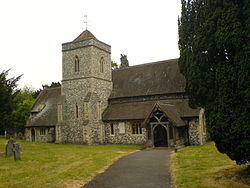Harpsden
| Harpsden | |
| Oxfordshire | |
|---|---|
 Parish Church of Saint Margaret | |
| Location | |
| Grid reference: | SU763809 |
| Location: | 51°31’19"N, 0°54’5"W |
| Data | |
| Population: | 560 (2001) |
| Post town: | Henley-on-Thames |
| Postcode: | RG9 |
| Dialling code: | 01491 |
| Local Government | |
| Council: | South Oxfordshire |
| Parliamentary constituency: |
Henley |
Harpsden is a rural and semi-rural village immediately south of Henley-on-Thames in the very south of Oxfordshire. Its scattered centre is laid out half a mile from the River Thames, the county's southern border, the River Thames. The parish extends five miles inland from the Thames and borders Rotherfield Peppard to the west
Harpsden Wood begins at he southern edge of the village, stretching away towards Lower Shiplake, which is Site of Special Scientific Interest.
The village has neither a railway station nor shops, but has the main road from Reading to Henley.
Contents
History
Remains of a Roman villa have been found about half a mile south-west of the village.[1] In the 11th century during the reign of King Edward the Confessor the manor of Harpsden belonged to Wigod, the thegn of Wallingford. After the Norman Conquest, Harpsden became part of the Honour of Wallingford.[2]
The Church of England parish church, St Margaret[3] was originally late Norman, as evidenced by the piscina, font and a blocked doorway that survive from this period.[4] The current windows in the nave and chancel were inserted in the 14th century, and a stone effigy of a knight dates from the same period. In 1848–54 the Gothic Revival architect Benjamin Ferrey lengthened the nave and added the north aisle and tower. In 1879 the architect Henry Woodyer restored the chancel.[4]
Other notable buildings in the village include the Grade II* listed Harpsden Court: the current house largely dates back to the 17th century, and incorporates elements of the mediæval manor house. It was the home of the Hall family until 1855.[5]
A weatherboarded barn near the church bears the date 1689.[4] Bellehatch Park, about three-quarters of a mile south-west of the village, was built early in the 19th century. It is a Georgian neoclassical country house of five bays with a Doric porch and summerhouse.[1] It was the seat of the Liberal politician Cecil Norton, who was created first Baron Rathcreedan in 1916.
About the village
Harpsden Wood is an ancient woodland dating from at least 1600. It is a Site of Special Scientific Interest covering 73 acres.[6]
Sport
On film and television
Harpsden was used as a location in the Agatha Christie's Marple episodes "Nemesis" and "By the Pricking of My Thumbs".[9]
Harpsden Court has also been used as the set for many films, including Quantum of Solace. [10]
Outside links
| ("Wikimedia Commons" has material about Harpsden) |
References
- ↑ 1.0 1.1 Sherwood & Pevsner, 1974, page 635
- ↑ Reynolds, 1962, pages 261–267
- ↑ Parish Churches of Shiplake, Dunsden and Harpsden
- ↑ 4.0 4.1 4.2 Sherwood & Pevsner, 1974, page 634
- ↑ A History of the County of Oxford - Volume 16 pp 231-265: Rural Parishes: Harpsden (Victoria County History)
- ↑ SSSI listing and designation for Harpsden Wood
- ↑ Harpsden Cricket Club
- ↑ Henley Golf Club
- ↑ DVDs from "Agatha Christie's Marple, de complete collectie, seizoenen 1-5"
- ↑ House Beautiful